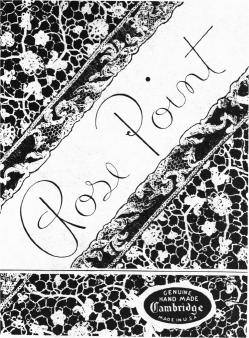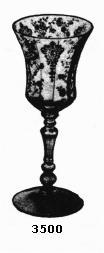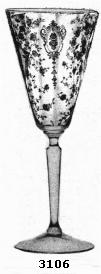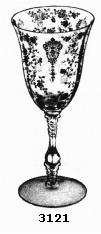Rose Point -- Its Beginnings
by Lynn Welker
Issue #55 - November 1977
Rose Point was first produced in 1934 and introduced to the trade in early 1935. It was an immediate success for the Cambridge Glass Company, and proved to be a staple item in the Cambridge Line, as it was produced until the plant was closed.
 Some of its success can be attributed to the fact that there was
matching silverware made by the Wallace Silver Company, and matching
china made by the Pope-Gosser China Company.
Some of its success can be attributed to the fact that there was
matching silverware made by the Wallace Silver Company, and matching
china made by the Pope-Gosser China Company.
Elaborate displays of these coordinating items in many of America's leading department and jewelry stores helped the sale of Rose Point Crystal. The Cambridge Glass Company augmented these displays with a deluge of very effective advertising on the Rose Point Line.
Rose Point was also popular because of the large number of serving and accessory pieces available. Building a large set of matching crystal was stressed by those in the trade, and the size of the Rose Point Line aided crystal collectors in building a thoroughly complimented set of crystal.
The greatest part of the success of Rose Point must be accounted for by its beauty. The delicate floral vines surrounding an elaborate medallion were copied from a French lace, long popular to brides in America. Thus, it had an added selling point to girls about to be married in the 30's and 40's, when this lacy design was so popular. This may explain why so much of the Rose Point found today was originally Wedding crystal.
The design itself will vary from piece to piece, mainly in the size of the etching. The etching will be much smaller on items such as a wine glass, than the etching will be on a large item, such as a floral bowl.
A limited number of items with small surfaces, such as an individual ashtray, or the bottom of some covered pieces, will have the etched vine only, and lack the medallion generally found on Rose Point pieces. Some pieces may have only three medallions while others will have four or five medallions.
There will be other variations in the etching as seen on the #3400 Line cups. These have only the top part of the medallion ending in the raised corner which extends from the bottom of the cup.



Stemware was among the first items to be introduced with the Rose Point etching. The #3500 Line (Gadroon) was the first stem line introduced in Rose Point. It was used throughout the entire production of Rose Point by Cambridge.
The #3106 stem line was introduced into the Rose Point Line shortly after the #3500 Line. The #3106 stem line in Rose Point was short lived, however, and was discontinued before 1940.
The #3121 Line stemware was the last to be introduced sometime in the late 30's. It proved to be the most popular of the three stem lines that were available in the Rose Point pattern.
The #3121 Line is the easiest of the Rose Point stem lines to be found and the #3106 Line is the hardest. However, the demand for the #3121 and #3500 Lines is much greater as the stem lines are more elaborate than the plain design of the #3106 stem. Also, the possibility of building a set of #3106 stemware in Rose Point is not at all likely and would be extremely difficult.
The #3500 Line stemware in Rose Point consisted of fifteen different stems. The 7 oz. tall sherbet is commonly referred to as a champagne and the 13, 12, and 10 oz. ftd. tumblers are often called iced teas. In the #3500 Line Rose Point stemware the hardest items to find are the short bowl goblet, the cafe parfait, the claret, the wine, and the 13, 12 and 2½ oz. ftd. tumblers. The most desirable pieces, value wise, are the cordials and the cafe parfaits.
It is not known just exactly what pieces were made in the #3106 Rose Point stemware line. However, the author has seen the 9 oz. tall water goblet (pictured), the 7 oz. tall sherbet, the 7 oz. short sherbet, and the 3 oz. cocktail. Other pieces in Rose Point in the stem line are very possible as there were seventeen different blank bowls available on the #3106 stem.
The #3121 Line stemware in Rose Point was available in fourteen different stems. Thirteen of them are shown (see catalog page), and the fourteenth one is a 5 oz. cafe that is not pictured.
The 6 oz. tall sherbet is often called a champagne, and the 12 and 10 oz. ftd. tumblers are called iced teas in this line also. The hardest stems to find in the #3121 Rose Point Line are the wine, the claret, the 2½ oz. ftd. tumbler, and the cafe parfait. Value wise, the most desirable pieces are the cordial, the brandy, and the cafe parfait.
(This is the beginning of a series of articles on Rose Point. Please write us about any unusual finds in Rose Point so they may be included in these articles.)
